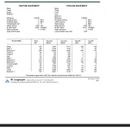Sizing a Geothermal Heat Pump
Hello All,
I have some questions regarding sizing of a geothermal pump that I had installed 18 months ago. I did see the previous thread on geothermal pump sizing:
Background:
I have a 1780 sq ft older home ( I believe built in 1930s but with a more recent addition in the 1990s) in Cleveland; it was previously heated using a 3 ton electric heat pump which I believe did the job fine. I had a geothermal system put in about 18 months ago by a HVAC contractor that exclusively installs geothermal pumps. He installed a 4 ton, 2-stage Hydron Module pump, basing sizing on “experience” rather than performing a Manual J. He didn’t recommend any changes prior to the install to reduce load like air sealing, additional insulation, etc. as mentioned in earlier posts.
I’ve had several contractors that eyeballed it say they thought it should be more like a 2.5 or 3 ton for this house. I recently had another contractor do a Manual J (summary image attached), although I think it is a stripped-down version. He felt that the house needed a 2.5 ton unit based on his result (he also said the sizing should be based on the the cooling load). The contractor that installed the system says he sizes his systems based on heating load. As an aside, I found it quite difficult to find an HVAC contractor willing to perform a Manual J as a standalone service..
I pulled the data log from the thermostat, and I’m hoping this can help shed some light on whether my unit is oversized (readout attached). I’m not sure if just having the monthly cycle count and run times provides enough information for that; the thermostat seems to only save detailed hourly data from the past week. (I didn’t know about the data log function until recently, so I don’t have earlier detailed hourly or daily logs).
My main questions are: Is this unit oversized? Do the cycling rate and run times suggest it is oversized? Is there a certain proportion of time a dual stage heat pump should run in stage 1 versus 2?
Besides opinions of other contractors, one reason I’m afraid it may be oversized is that I have also noticed that humidity in the house was very high in the summers since it was installed, often in the high 70s. The basement doesn’t have water issues, but does have a communicating dirt crawlspace. The basement was waterproofed a couple months before installing the geothermal Unit. Putting a dehumidifier in the basement hasn’t help at all with house humidity level. We did have the ducting supply and return size increased to accommodate the larger pump per recommendation of the geo installer, but this also didn’t help the humidity issue. As of yet I haven’t done any additional air sealing or insulation.
My other question is, assuming the heat pump is appropriately sized, is there anything that can be done to make the geothermal unit perform a better job dehumidifying in the summer?
Thanks everyone,
Salim
GBA Detail Library
A collection of one thousand construction details organized by climate and house part










Replies
It seems your system is almost certainly oversized.
Since the cooling season is over it is almost too late to complain. The over sized system will perform well in heating mode. Get your complaint on record today if you have not yet had several service call describing you discomfort.
The text book complaint for an oversized system is “the house is cold and clammy”.
Short of replacing the equipment they may install a dehumidifier to convert latent heat into sensible heat your system can easily deal with this will work well but will be expensive to operate if you move the dehumidifier upstairs.
I did not see a summer time relative humidity number have you kept a log?
Walta
Thank you; Unfortunately the only logs for outside/inside relative humidity I have are in the spreadsheet. I believe columns J-K and N-O show minimum and maximum relative humidity for outdoors and indoors, respectively, during specified time intervals, with weekly stats going back to beginning of this August and monthly stats going back to the install date March 2020.
Working with the installing contractor has been quite the ordeal ; I've actually been asking him about the humidity since last summer and is well documented in emails. He keeps insisting it is properly sized based on his "17 years experience" and says he does not ever perform Manual Js. Since I have a 2 year warranty from the installer, I'm hoping they will swap it out for an appropriate sized system if I show objective data it is currently oversized.
> make the geothermal unit perform a better job dehumidifying
Generically, you want to reduce the CFM/ton. And always be sure that the fan doesn't run when the compressor is off. Get these right and over-sizing has little effect on dehumidification. See Fig 2-5 (upper line) here.
In mild weather, you probably want an upstairs dehumidifier (with any system).
Thank you; is it typically possible to program the fan toward that type of performance?